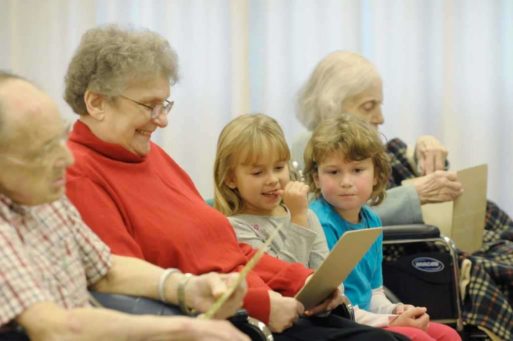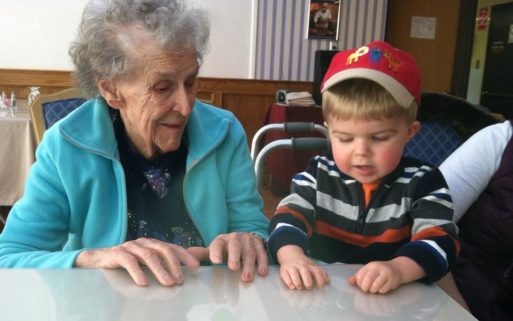A few years ago a preschool in Seattle, Washington, distinguished itself in newscasts across the nation because it operated within Providence Mount St. Vincent, a senior care center in West Seattle, Washington. At “the Mount” the children and residents come together five days a week in a variety of planned activities such as music, dancing, art, lunch, storytelling or just visiting. The collaboration had been going on for years.

Credit: Paul Buckowski/timesunion.com
Intergenerational Learning Centers
The spotlight on the long-standing intergenerational learning center came about when Evan Briggs, a video director at Seattle Children’s Hospital, filmed the interaction between young and old over the course of the 2012-2013 school year. According to Briggs, residents completely transformed in the presence of the children. “Moments before the kids came in, sometimes the people seemed half alive, sometimes asleep… As soon as the kids walked in… the residents came alive.”
Ever since, Briggs has been working on a documentary of the nursery school/nursing home collaboration. A film trailer that raised funds for the project showed how “the kids took everything in their stride.” One young boy remained exceedingly patient with an elderly man who had trouble remembering the boy’s name.”He just kept repeating his name over and over,” says Briggs. The film is expected to be ready for release soon.
Intergenerational Intelligence
In a TED talk on the importance of bringing together elders and youngsters, Briggs says the scenes she filmed at the Mount mostly showed “people being present with one another.” She explains that by sharing this presence, they not only acknowledged each other’s inherent value as humans, but also became able to put themselves in the shoes of a different generation, a concept scholars refer to as intergenerational intelligence.
 In the talk, Briggs tells a touching story about youngsters and elders joining together to sing “You Are My Sunshine.”Afterwards a resident shared his memory of driving down a road late one night on an Army bus full of soldiers singing the same tune. This is how we learn “the cyclical nature of life itself,” says Briggs.
In the talk, Briggs tells a touching story about youngsters and elders joining together to sing “You Are My Sunshine.”Afterwards a resident shared his memory of driving down a road late one night on an Army bus full of soldiers singing the same tune. This is how we learn “the cyclical nature of life itself,” says Briggs.
Big Words Translate to Simple Deeds
Living intergenerationally is becoming even more important since, by 2050, our elderly population will more than double. While intergenerational learning centers grow in number, we can reap the benefits of our youngest members of society — and ourselves — interacting with our oldest members in the simplest ways. Briggs suggests we call our grandparents or start a conversation with the older person you see at the bus stop everyday. Local retirement homes welcome regular visits. And the local library would be a great place to start an intergenerational book club. “Anyone can do it at anytime, and just imagine the difference it could make,” says Briggs.

 Intergenerational Learning Brings Together the Young and Old
Intergenerational Learning Brings Together the Young and Old



 How to Comfort A Dying Loved One
How to Comfort A Dying Loved One
 Our Annual Seven Holiday Gifts for Someone Who Is Grieving, 2024 Edition
Our Annual Seven Holiday Gifts for Someone Who Is Grieving, 2024 Edition














